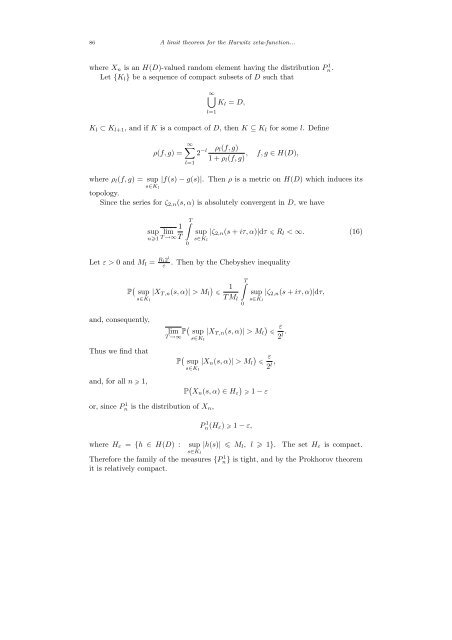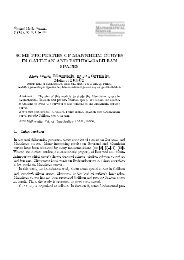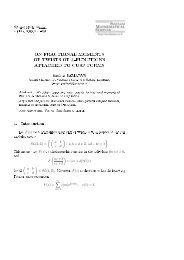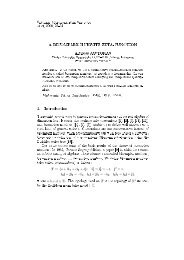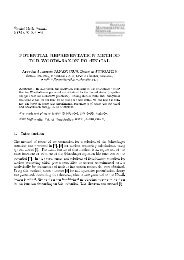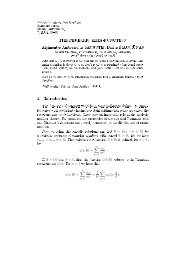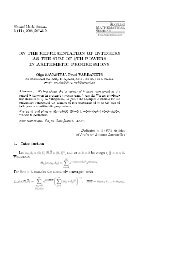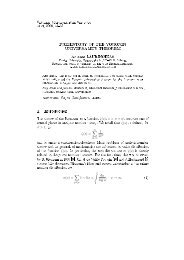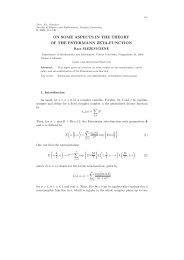a limit theorem for the hurwitz zeta-function in the space of analytic ...
a limit theorem for the hurwitz zeta-function in the space of analytic ...
a limit theorem for the hurwitz zeta-function in the space of analytic ...
You also want an ePaper? Increase the reach of your titles
YUMPU automatically turns print PDFs into web optimized ePapers that Google loves.
86 A <strong>limit</strong> <strong><strong>the</strong>orem</strong> <strong>for</strong> <strong>the</strong> Hurwitz <strong>zeta</strong>-<strong>function</strong>...<br />
where X n is an H(D)-valued random element hav<strong>in</strong>g <strong>the</strong> distribution P 1 n.<br />
Let {K l } be a sequence <strong>of</strong> compact subsets <strong>of</strong> D such that<br />
∞⋃<br />
K l = D,<br />
l=1<br />
K l ⊂ K l+1 , and if K is a compact <strong>of</strong> D, <strong>the</strong>n K ⊆ K l <strong>for</strong> some l. Def<strong>in</strong>e<br />
ρ(f, g) =<br />
∞∑<br />
l=1<br />
2 −l ρ l (f, g)<br />
, f, g ∈ H(D),<br />
1 + ρ l (f, g)<br />
where ρ l (f, g) = sup<br />
s∈K l<br />
|f(s) − g(s)|. Then ρ is a metric on H(D) which <strong>in</strong>duces its<br />
topology.<br />
S<strong>in</strong>ce <strong>the</strong> series <strong>for</strong> ζ 2,n (s, α) is absolutely convergent <strong>in</strong> D, we have<br />
sup<br />
lim<br />
n1 T →∞<br />
1<br />
T<br />
∫ T<br />
0<br />
sup |ζ 2,n (s + iτ, α)|dτ R l < ∞. (16)<br />
s∈K l<br />
Let ε > 0 and M l = R l2 l<br />
ε<br />
. Then by <strong>the</strong> Chebyshev <strong>in</strong>equality<br />
P ( )<br />
sup |X T,n (s, α)| > M 1<br />
l <br />
s∈K l<br />
T M l<br />
∫T<br />
0<br />
sup |ζ 2,n (s + iτ, α)|dτ,<br />
s∈K l<br />
and, consequently,<br />
Thus we f<strong>in</strong>d that<br />
and, <strong>for</strong> all n 1,<br />
lim P( )<br />
sup |X T,n (s, α)| > M ε l <br />
T →∞ s∈K l<br />
2 l .<br />
P ( )<br />
sup |X n (s, α)| > M ε l <br />
s∈K l<br />
2 l ,<br />
P ( X n (s, α) ∈ H ε<br />
)<br />
1 − ε<br />
or, s<strong>in</strong>ce P 1 n is <strong>the</strong> distribution <strong>of</strong> X n ,<br />
P 1 n(H ε ) 1 − ε,<br />
where H ε = {h ∈ H(D) : sup |h(s)| M l , l 1}. The set H ε is compact.<br />
s∈K l<br />
There<strong>for</strong>e <strong>the</strong> family <strong>of</strong> <strong>the</strong> measures {Pn} 1 is tight, and by <strong>the</strong> Prokhorov <strong><strong>the</strong>orem</strong><br />
it is relatively compact.


